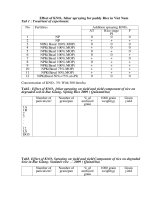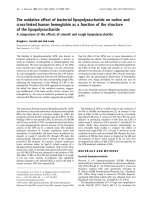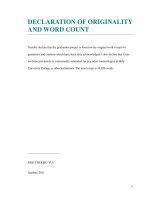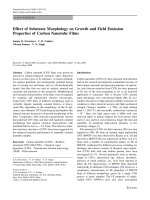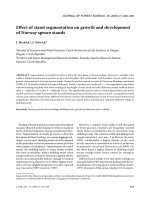Effect of stitch length on Lycra And Without Lycra plain Single jersey fabric dimension & properties
Bạn đang xem bản rút gọn của tài liệu. Xem và tải ngay bản đầy đủ của tài liệu tại đây (760.29 KB, 33 trang )
Eect of stch length on Lycra And Without Lycra plain Single jersey fabric dimension &
properes
Presentaon
on
Prepared By : Mazadul Hasan sheshir
ID: 2010000400008
13
th
Batch (session 2009-2013)
Department : Wet Processing Technology
Email:
Blog : www. Texlelab.blogspot.com (visit)
Southeast University
Department Of Textile Engineering
I/A 251,252 Tejgaon Dhaka Bangladesh
Prepared By :
Introducon
Knitted fabrics are the preferred structures in athletic wear in which demand for comfort is a key requirement. Fabric properties are an important matter to
produced athletic fabrics.
In this study, an experimental work is presented to determine the effects of stitch length on plain single jersey cotton fabric with lycra and without lycra.
The experimental work is going through various tests, test results, graphical representation and remarks on the test. Dimensional properties, pilling
resistance, spirality, fabric thickness, and some color fastness test are analyzed to get information about the effect of stitch length on plain single jersey
fabric.
From the analyses of variance, it is seen that the effects of stitch length on the dimension and properties of the Plain single fabrics inspected are highly
significant.
Sample fabric producon
Fabric Type : Plain Single Jersey (Lycra & without Lycra)
Yarn Type : Cotton (combed)
Yarn Count : 26 Ne, 70D
Stitch Length : 2.76mm, 2.97mm, 3.15mm
Machine Parameters
Brand name of m/c : Jiunn long (Taiwan)
Machine Diameter : 26 inch
No of Feeder : 78
Needle Gauge : 24
No of Needle : 1968T
Machine speed : 26 rpm
Dierent tests & calculaon
Tests on Grey Sample Fabric
Spirality Test.
Pilling Test.
GSM Calculation.
CPI, WPI & Fabric Width Calculation.
Dimensional Stability Test.
Fabric Thickness Test.
Tests on Dyed Sample Fabric
Color fastness to Rubbing
Color Fastness to Wash
Color Fastness to Perspiration
Spirality
Spirality can be defined as a fabric condition resulting when the knitted wales and courses are angularly displaced from that ideal perpendicular angle.
In other words, Spirality" arises from twist stress in the constituent’s yarns of plain fabric, causing all loops to distort and throwing the fabric wales and courses
into an angular relationship other than 90 degree.
Impact of fabric stch length on spirality
Plain S/J Fabric without Lycra
Stitch Length(mm) No. of Feeders Spirality %
2.76 78 6.15
2.97 78 8.10
3.15 78 9.5
!""""""""""""" #!#############$ %&'
"
""&
""
""%
""(
""'
""!
""
""$
""#
"&
!&')
$&")
#'")
Stch Length
spirality %
Plain S/J Fabric with Lycra
Stitch Length(mm) No. of Feeders Spirality %
2.76 78 2.15
2.97 78 3.10
3.15 78 3.50
!""""""""""""" #!#############$ %&'
"
""&
""&
""
""
""%
""%
""(
""(
""
""%
""(
Stch Length
spirality %
Piling
Pilling is a surface defect of textiles caused by wear, and is considered unsightly. It happens when washing and wearing of fabrics causes loose fibres to begin to
push out from the surface of the cloth, and, over time, abrasion causes the fibres to develop into small spherical bundles, anchored to the surface of the fabric by
protruding fibres that haven't broken.
Fig: Pilling of Fabric
Impact of fabric stch length on pilling
Plain S/J Fabric without Lycra
Stitch Length(mm) Pilling Scale Grade (out of 5)
2.76 4/5
2.97 3
3.15 2/3
!""""""""""""" #!#############$ %&'
"
"'
&
&'
'
%
%'
(
('
'
('
%
'
Stch Length
Pilling Scale Grade
Stitch Length(mm) Pilling Scale Grade (out of 5)
2.76 4
2.97 3
3.15 3
Table: Impact of stitch length on pilling (Widthwise)
"
"'
&
&'
'
%
%'
(
('
(
'
%
Stch Length
Pilling Scale Grade
Graph: Graphical relationships between stitch length and pilling (widthwise)
Plain S/J Fabric with Lycra
Stitch Length (mm) Pilling Scale Grade (out of 5)
2.76 4
2.97 4
3.15 4
Table: Impact of stitch length on pilling (lengthwise)
"
"'
&
&'
'
%
%'
(
('
( ( (
Stch Length
Pilling Scale Grade
Graph: Graphical relationships between stitch length and pilling (lengthwise)
Stitch Length (mm) Pilling Scale Grade (out of 5)
2.76 4
2.97 4
3.15 4
Table: Impact of stitch length on pilling (Widthwise)
"
"'
&
&'
'
%
%'
(
('
(
(
(
Stch Length
Pilling Scale Grade
Graph: Graphical relationships between stitch length and pilling (Widthwise)
GSM
The GSM of fabric is one kind of specification of fabric which is very important for a textile engineer for understanding and production of fabric. ‘GSM’ means
‘Gram per square meter’ that is the weight of fabric in gram per one square meter. By this we can compare the fabrics in unit area which is heavier and which is
lighter.
There are two formulas for calculating the GSM of a knitted fabric
Course per inch X Stitch length X 39.37 X 39.37 X Tex
GSM =
1000 X 1000
And
WPI X CPI X SL (mm)
GSM = X 0.9155
Count (Ne)
Impact of fabric stch length on fabric GSM
Plain S/J Fabric without Lycra & with Lycra
Plain S/J
Fabric
without
Lycra
Stitch Length
(mm)
GSM
Plain S/J
Fabric with
Lycra
Stitch Length
(mm)
GSM
2.76 152 2.76 240
2.97 141 2.97 234
3.15 127 3.15 220
"
'"
&""
&'"
""
'"
%""
&'
&(&
&
(" %(
"
Stch Length
GSM
Courses per inch
Courses per inch mean how many numbers of courses are present in one inch. It is also very important for calculation of knitted fabric GSM.
Wales per inch
Wales per inch means how many numbers of wales are present in one inch, it is very important for calculation of knitted fabric GSM and fabric properties.
Calculaon of Fabric Width
We calculated the fabric width by using following formula –
Total no of Wales/Total no of needle
Fabric Width (open width) =
WPI
Impact of fabric stch length on cpi, wpi & fabric width
Stitch
Length (mm)
CPI WPI Fabric Width
(Inch
2.76 54 29 67.9
2.97 48 28 70.3
3.15 44 26 75.7
!""""""""""""" #!#############$ %&'
"
&"
"
%"
("
'"
!"
"
$"
'(
($
((
#
$
!
! #
"%
'
*+,
+,
-
Stch Length
CPI,WPI&F.W
Plain S/J Fabric without Lycra
Plain S/J Fabric with Lycra
Stitch Length
(mm)
CPI WPI Fabric Width
(Inch)
2.76 67 37 53.2
2.97 64 35 56.2
3.15 60 33
59.6
"
&"
"
%"
("
'"
!"
"
$"
!
!(
!"
%
%'
%%
'%
'!
'#!
*+,
+,
-
Stch Length
CPI,WPI& F.W
Dimensional Stability
This is a test method for measuring the changes in fabric dimension when subjected to changing humidity conditions. The dimensional stability relating
properties, namely relaxation shrinkage and hygral expansion, are measured. Relaxation shrinkage is defined as the percentage change in dry dimensions of
fabric measured after 30-minute relaxation in water at room temperature. Hygral expansion is defined as the percentage change in dimensions of relaxed fabric
from wet condition to dry condition.
Impact of Fabric stch length on Fabric Dimensional Stability
Stitch Length (mm) Lengthwise Shrinkage
(%)
Widthwise Shrinkage
(%)
2.76 5 20
2.97 6 18
3.15 5 11.5
Plain S/J Fabric without Lycra
"
""'
"&
"&'
"
"'
""'
""!
""'
"
"&$
"&
Stch Length
Shrinkage Percentage
Plain S/J Fabric with Lycra
Stitch Length (mm) Lengthwise
Shrinkage
(%)
Widthwise
Shrinkage
(%)
2.76 14 11
2.97 16 13
3.15 6 18
"
""
""(
""!
""$
"&
"&
"&(
"&!
"&$
"
"&(
"&!
""!
&&) &%)
"&$
Stch Length
Shrinkage Percentage
Fabric Thickness
Fabric thickness is defined as perpendicular distance through the fabric, which determines the dimension between the upper and lower side of the fabric
Fig: Fabric Thickness Tester
Impact of Fabric stch length on Fabric Thickness
Plain S/J Fabric without Lycra
Stitch Length (mm) Fabric Thickness (mm)
2.76 0.5
2.97 0.47
3.15 0.38
!""""""""""""" #!#############$ %&'
"
"&
"
"%
"(
"'
"!
"'
"(
"%$
Stch Length
Fabric Thickness (mm)
Plain S/J Fabric with Lycra
Stitch Length (mm) Fabric Thickness (mm)
2.76 0.70
2.97 0.57
3.15 0.52
"
"&
"
"%
"(
"'
"!
"
"$
"
"'
"'
Stch Length (mm)
Fabric Thickness (mm)


